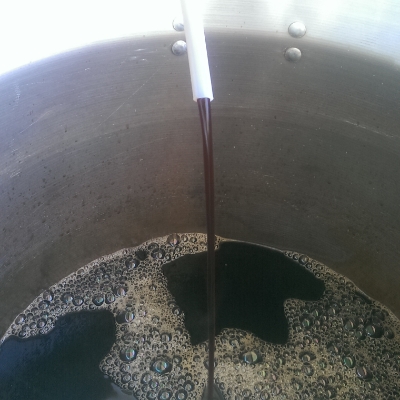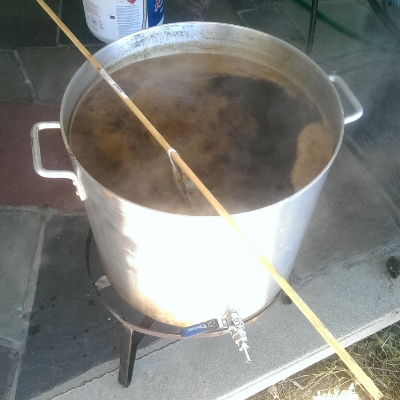Barrel Aged Russian Imperial Stout
A 10 gallon used corn whiskey barrel from Sons of Liberty Spirits.
I've done wood aged beers in the past, both clean and sour, but those were always done with toasted oak cubes that were either boiled or soaked in spirits before being added to the beer for aging. So this will be my first beer using an actual barrel and I couldn't be more excited. I have at least two clean beers I want to put though the barrel to strip away most of the big, bold flavors that the wood and whiskey will impart before aging sours in it, the first one will be detailed below, a big, luscious, thick Russian Imperial Stout, and the second will be a slightly left of center choice in an English Dark Mild.
For the Russian Imperial Stout, I'm using a recipe I've used multiple times before and really enjoy. Last year I brewed the same recipe, and aged it on oak cubes soaked in Crown Royal. I ended up loving it so much I blew through the keg and bottles before they were even a few months old! The recipe for this years batch is as follows:
Russian Imperial Stout Recipe, batch size 10.5 gallons:
Grains
26 lbs American 2-Row
2 lbs Chocolate Malt (350 SRM)
2 lbs Flaked Oats (Quick Oats from the store)
1 lbs Crystal Malt 40L
8oz Crystal Malt 120L
8oz Black Patent Malt (500 SRM)
Mash at 156F for 1 hour, batch sparge, and boil for 90 min
Boil additions:
2.25 oz Warrior Hops @First Wort Hopping
1 oz each Glacier and Liberty hops @30 minutes
0.75 oz of Norther Brewer @15 minutes
2 lbs of Dark Brown Sugar @15 minutes
Irish Moss @15 minutes
Fermentation Plan:
Grew up 2L starter of WLP090 San Diego Super Yeast, and used 1L for each carboy
Ferment at 62F for 5 days, then free rise to 70F and hold at 70F for 1 week
Bring carboys to basement (65F-70F), let settle for 3 days, then rack to barrel
Add 100g of dark brown sugar (boiled and cooled in 1 cup of water) to help purge oxygen from both the beer and barrel to help prevent oxidation.
It was another simple brew day, which is always good to have. I filled up my boil kettle with water straight from my tap, made no water adjustments, and heated up the water so I could mash in. After mashing, I added boiling water to heat the mash up to 170 so I could kill enzymatic activity and start collecting my first runnings.
Thick, roasty motor oil going into the kettle.
The boil went off without a hitch, this was kind of a kitchen sink hops beer, using up stuff I had in my freezer that I knew would go well with the style, but that would fade gently into the night as it ages. When adding the brown sugar, you have to be a bit careful to make sure you stir real well after the addition to make sure it all gets into solution and doesn't just scald and burn on the bottom of your kettle.
I'm sorry this isn't a scratch and sniff blog.
With the boil complete, I chilled the beer down to around 75F before filling up my carboys and then placing them in my fermentation chamber set at 62F where I let them sit until both carboys cooled down to that temp. I measure out 1L of WLP090 starter and added it to each carboy and then shut the door to let the yeast do their thing.
24 hours after pitching yeast, churning along nicely.
After 5 full days, I set my chamber to 70F, and let it free rise to that temp and then held it for 1 week before bringing the carboys down into my basement and let the beer settle for 3 days before transferring to the barrel. I added some extra sugar to the beer after transfer to help purge any oxygen that may have been introduced during the transfer process and also to purge the head space in the barrel.
My first barrel fill!
I tasted the beer after 2 weeks in the barrel and was in love. There was a big whiskey nose on it, though the flavor didn't overpower the beer itself. You could start to get hints of the oak barrel character coming through, but I wanted just a touch more so I let it go another week and a half before bottling 5 gallons in a mix of 22oz bombers and 12oz bottles for competition. The remaining beer was kegged and force carbonated.
I started pulling samples after a few days on CO2 and was floored. For a bigger beer that was only a month and a half old, it was phenomenally balanced. I could just smell the beer all night and get just as much enjoyment out of it as I was getting from drinking it. A warm whiskey nose with a background of coconut, vanilla, and chocolate. And the taste, oh man the taste. It was a bit thin going into the barrel, but coming out it's luscious and coats your mouth in a big chocolaty stout that's got a hint of bitterness from the hops and a whole lot of oak and whiskey shining through. This is hands down the best beer I've brewed to date and everyone I've shared it with has loved it too.
So dark, so beautiful, so tasty.
Final numbers for my Barrel Aged Russian Imperial Stout:
Batch Size: 10.5 gallons
Original Gravity: 1.084
Final Gravity: 1.021
ABV: 8.92%
IBU: 65






